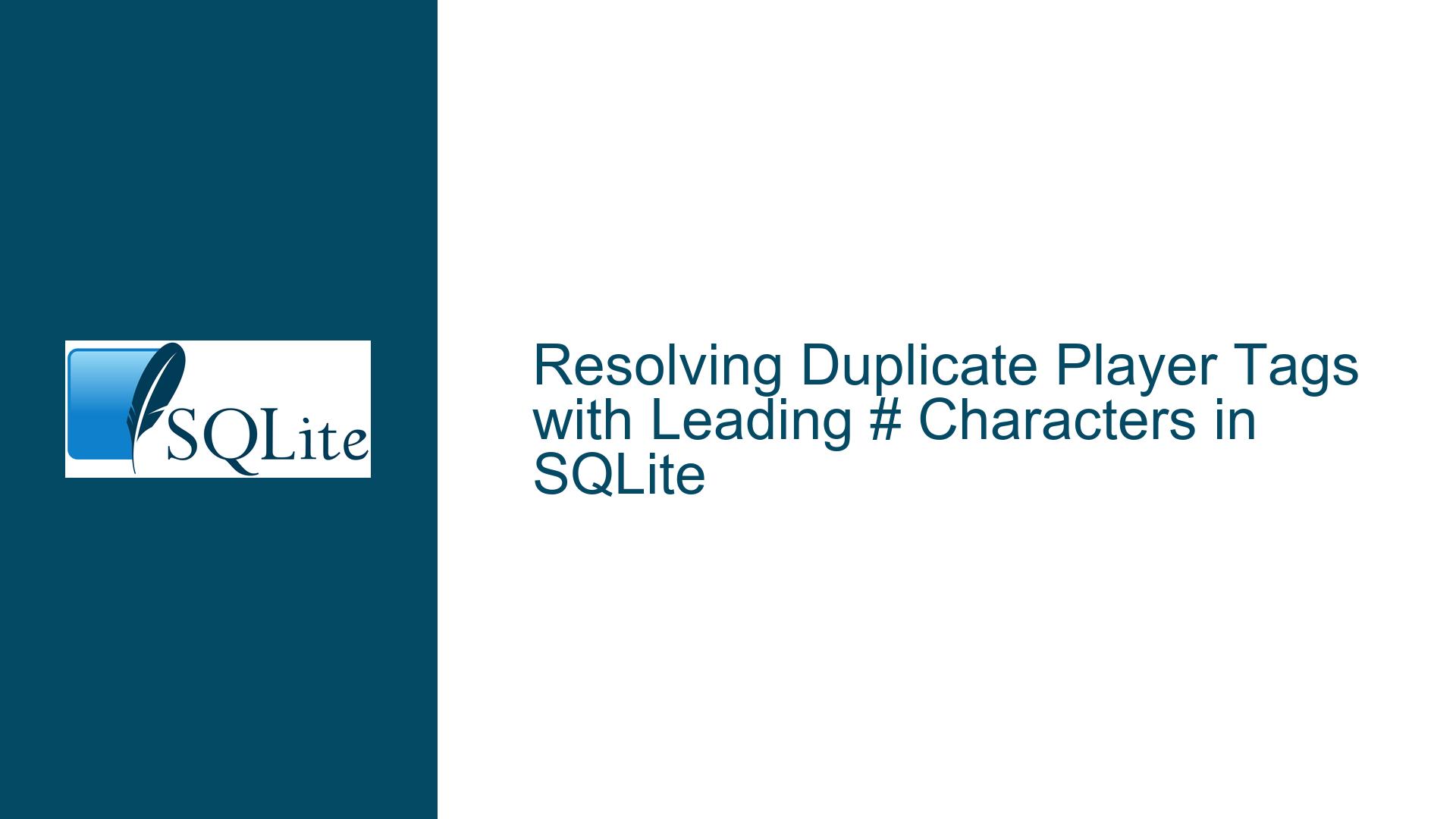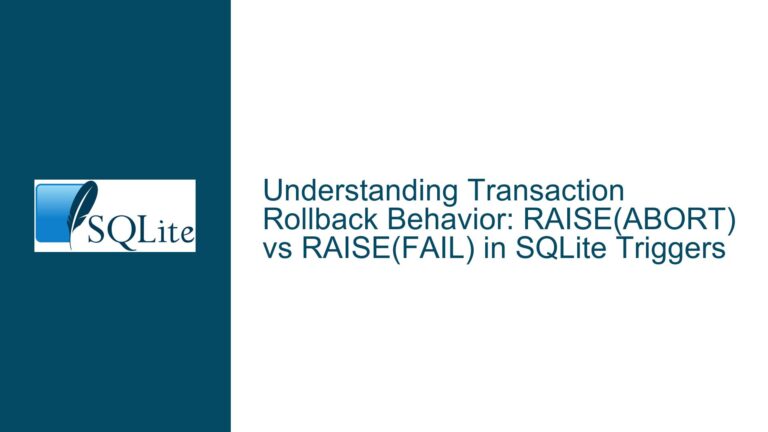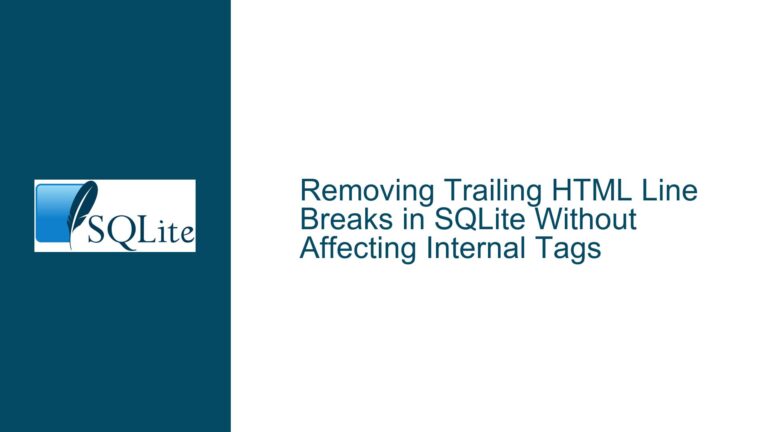Resolving Duplicate Player Tags with Leading # Characters in SQLite
Identifying and Removing Duplicate Player Tags Containing Leading # Symbols
Understanding the Core Problem: Duplicate Player Tags with Leading #
The primary challenge involves a SQLite table named players structured with a player_tag column that enforces uniqueness via a UNIQUE constraint. The issue arises when duplicate entries exist where one player_tag starts with a # character (e.g., #Y123456), and another entry exists without it (e.g., Y123456). The goal is to delete all rows where the player_tag contains a leading # only if a corresponding entry without the # already exists. Directly removing the # from all such tags via an UPDATE operation would violate the uniqueness constraint, necessitating a strategy to identify and delete the redundant entries safely.
Key observations:
- The
player_tagvalues with a leading#are considered duplicates if their suffix matches anotherplayer_tagwithout the#. - The
UNIQUEconstraint onplayer_tagprevents straightforward updates or inserts that would create duplicates. - The solution must avoid unintended data loss by ensuring that only true duplicates (i.e., pairs where both
#Y123456andY123456exist) are removed.
Root Causes of Duplication and Constraint Violations
Improper Data Sanitization During Ingestion
The presence of#prefixes inplayer_tagvalues suggests that input data was not normalized before insertion. For example, an application might have allowed variations of the same identifier (with or without#) to be inserted into the table without checks.Case Sensitivity and String Comparison Nuances
SQLite’s defaultLIKEoperator is case-insensitive unless configured otherwise. Ifplayer_tagvalues are case-sensitive (e.g.,#y123456vs.Y123456), failing to enforce case-sensitive comparisons could lead to incorrect identification of duplicates. TheUNIQUEconstraint respects case sensitivity, so mismatches in case handling during duplicate detection may result in incomplete cleanup.Incomplete Conflict Resolution Strategies
Attempting to normalizeplayer_tagvalues (e.g., stripping#characters) without a conflict resolution clause (e.g.,UPDATE OR IGNORE) will fail due to theUNIQUEconstraint. Without proper handling, such operations abort upon encountering the first duplicate, leaving the dataset partially modified.Misuse of Subqueries in Deletion Logic
A suboptimalDELETEquery that scans the entire table or uses inefficient string manipulation (e.g.,REPLACE()) can lead to performance issues or incorrect targeting of rows. For example, usingEXISTS (SELECT 1 FROM players WHERE player_tag = REPLACE(o.player_tag, '#', ''))without limiting the scope toplayer_tagvalues starting with#would process every row, increasing execution time.
Comprehensive Solutions for Safe Deletion and Prevention
Step 1: Enable Case-Sensitive Comparisons (If Required)
If player_tag values are case-sensitive, configure SQLite to perform case-sensitive LIKE operations:
PRAGMA case_sensitive_like = 1;
This ensures that WHERE player_tag LIKE '#%' correctly identifies player_tag values starting with # without matching lowercase # or other variations.
Step 2: Identify Duplicate Pairs Using Substring Matching
To locate player_tag values with a leading # that have a corresponding duplicate without it:
-- Method 1: Using EXISTS with SUBSTR
SELECT rowid, player_tag
FROM players o
WHERE
o.player_tag LIKE '#%'
AND EXISTS (
SELECT 1
FROM players
WHERE player_tag = SUBSTR(o.player_tag, 2)
);
-- Method 2: Self-Join with SUBSTR
SELECT x.rowid, x.player_tag
FROM players x
JOIN players y ON y.player_tag = SUBSTR(x.player_tag, 2)
WHERE x.player_tag LIKE '#%';
Both queries return rowids of rows where player_tag starts with # and has a duplicate without the #. The second method uses a self-join for faster lookups on large datasets.
Step 3: Delete Identified Duplicates
Use the rowids from the previous step to delete duplicates:
DELETE FROM players
WHERE rowid IN (
SELECT x.rowid
FROM players x
JOIN players y ON y.player_tag = SUBSTR(x.player_tag, 2)
WHERE x.player_tag LIKE '#%'
);
Step 4: Normalize Remaining player_tag Values
After deleting duplicates, remove # prefixes from any remaining player_tag values to prevent future conflicts:
UPDATE OR IGNORE players
SET player_tag = SUBSTR(player_tag, 2)
WHERE player_tag LIKE '#%';
The OR IGNORE clause skips updates that would violate the UNIQUE constraint (e.g., if two #Y123456 entries exist but only one can be normalized).
Step 5: Clean Up Residual Duplicates
Any remaining player_tag values with # after the update are duplicates that couldn’t be normalized. Delete them:
DELETE FROM players
WHERE player_tag LIKE '#%';
Step 6: Prevent Future Duplicates
Add a trigger to automatically strip # characters from new player_tag values before insertion:
CREATE TRIGGER normalize_player_tag
BEFORE INSERT ON players
BEGIN
SELECT RAISE(ABORT, 'Duplicate player_tag')
WHERE EXISTS (
SELECT 1
FROM players
WHERE player_tag = SUBSTR(NEW.player_tag, 2)
);
UPDATE players
SET player_tag = SUBSTR(NEW.player_tag, 2)
WHERE player_tag = NEW.player_tag;
END;
This trigger prevents insertion of player_tag values that would become duplicates after normalization.
Performance Optimization Tips
- Index on
player_tag: Ensure an index exists for faster lookups:CREATE INDEX idx_player_tag ON players(player_tag); - Batch Processing: For large tables, process deletions in batches to avoid locking:
DELETE FROM players WHERE rowid IN ( SELECT rowid FROM players WHERE player_tag LIKE '#%' LIMIT 1000 ); - Transaction Blocks: Wrap operations in transactions to ensure atomicity and improve speed:
BEGIN TRANSACTION; -- Perform DELETE/UPDATE operations COMMIT;
Edge Cases and Validation
- Mixed Case Duplicates: If
player_tagpermits case variations (e.g.,#y123456andY123456), adjust theSUBSTRand comparison logic to useLOWER()orUPPER(). - Multi-Character Prefixes: If duplicates involve prefixes longer than
#, modify theSUBSTRoffset (e.g.,SUBSTR(player_tag, N)for anN-character prefix). - Concurrent Modifications: Ensure no other processes are writing to the table during cleanup to prevent race conditions.
By methodically identifying duplicates, normalizing data, and implementing safeguards, this approach ensures data integrity while efficiently resolving conflicts. The combination of precise substring matching, transaction-aware operations, and preventive triggers addresses both immediate cleanup and long-term consistency.






